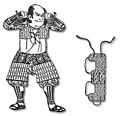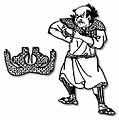- Wakibiki
-
Wakibiki are a Japanese armour component that were worn by the samurai class of feudal Japan. Wakibiki are a form of arm pit protector, that along with the manju no wa and manchira were auxiliary forms of armored clothing worn underneath (sometimes over) the chest armor (dou or dō) for protection of certain areas of the underarm, shoulder, chest and neck. These auxiliary armors would be covered with solid iron or leather plates, kusari (chain armour), karuta (small square or rectangular plates), kikko (hexagon plates) or a combination of these armors which were sewn to a cloth backing.[1][2] The tate-eri is another form of armored padding.[3]
Contents
Description
The wakibiki is a simple rectangle of cloth covered with kusari (chain armor), karuta (small rectangular or square plates), or kikko (hexagon plates), these iron or leather armors or a combination of them were sewn to the cloth backing. Wakibiki could also be made from one solid piece of iron or hardened leather.[4] The wakibiki had cords connected to them which allowed the wakibiki to hang from the shoulder, the wakibiki was then suspended over the exposed arm pit area. Wakibiki were worn inside the of the chest armour dou (dō) or on the outside depending on the type.[5][6]
The manju no wa , ( also manjunowa or manju nowa ) are a combination of shoulder pads, collar and armpit guards in one that protected the upper chest area. Manju no wa were covered with different types of armor including kusari (chain armour), karuta (small square or rectangular armor plates), or kikko (hexagon plates), these iron or leather armors or a combination of them were sewn to a cloth backing. The armor could be exposed or hidden between a layer of cloth. When worn the manju no wa looked like a small tight fitting vest. Manju no wa have small wings that would pass under the arm pit area from the back and attach to the front of the manju no wa with a button, toggle or ties.[7][8][9]
The manchira is type of armored vest covered with different types of armor including kusari (chain armour), karuta (small square or rectangular armor plates), or kikko (hexagon plates), these iron or leather armors or a combination of them were sewn to a cloth backing. The armor could be exposed or hidden between a layer of cloth. Manchira are usually larger than manju no wa and protected the chest area and sometimes the neck and arm pit. Some manchira could be worn over the chest armor dou (dō) .[10][11]
The tate-eri is a small padded pillow like piece with a standing armored collar that sits on the shoulder to protect from the weight of the chest armor (dou or dō) The standing collar would be lined with kikko (hexagon plates) armor to protect the neck.[12]
Gallery
Wakibiki
Manju no wa
Manchira
Tate-eri
References
- ^ Transactions of the Asiatic Society of Japan - Page 277 Asiatic Society of Japan - 1881
- ^ Samurai 1550-1600, Anthony J. Bryant, Angus McBride, Osprey Publishing, 1994 p.57
- ^ Japanese arms & armor, Crown Publishers, 1969 P.33
- ^ Samurai 1550-1600, Anthony J. Bryant, Angus McBride, Osprey Publishing, 1994 p.57
- ^ Transactions of the Asiatic Society of Japan, Asiatic Society of Japan - 1881, P.227
- ^ Samurai 1550-1600, Anthony J. Bryant, Angus McBride, Osprey Publishing, 1994 p.57
- ^ A glossary of the construction, decoration, and use of arms and armor in all countries and in all times: together with some closely related subjects. George Cameron Stone p.436
- ^ Secrets of the samurai: a survey of the martial arts of feudal Japan - Page 201 Oscar Ratti, Adele Westbrook - 1991
- ^ Arms and armor of the samurai: the history of weaponry in ancient Japan, Ian Bottomley, Anthony Hopson, Crescent Books, 1993 P.121
- ^ Arms and Armor of the Samurai Ian Bottomley, Anthony Hopson, 1993, p.143
- ^ Oriental armour H. Russell Robinson - 1967 p.228
- ^ Japanese arms & armor, Crown Publishers, 1969 P.33
External links
- Examination and restoration of an antique Japanese manchira
- Anthony Bryants web site.
- Pattern from Anthony Bryants web site.
Also see
Categories:
Wikimedia Foundation. 2010.


















